#the underground railroad show
Text
The Obi-Wan Kenobi miniseries is scattered moments of emotionally-devastating pure brilliance linked together by some of the most childishly dumb plot devices you can imagine.
#this could have been good#and in some moments it is#but there's so much nonsense in between that doesn't need to be there#there are so many pieces that are so good but they're put together in entirely the wrong way#like it's a top-of-the-line lego set put together by a monkey with a blindfold on#they had the obi-wan-vader confrontation as a pitch#how do you mess that up?#by throwing in a pointless extra villain for one#and by giving both of them their very own idiot ball to play with so they don't even have to fight for it#i've seen it suggested that since lucas ignores dialogue the best way to watch the prequels is to mute them#and just watch the images while the soundtrack plays#and for significant portions of this show that's how i'm having to approach it#beautiful aesthetic beloved characters some fascinating moments but please ignore the ham-handed dialogue that strings it together#i still love little leia and the force-sensitive underground railroad with all my heart though#and the whole series is almost worth it for that moment when kenobi's like 'i know what vader will do next' because he knows anakin so well#also for that double-agent lady#and a lot of the lightsaber fights are genuinely cool#star wars#obi-wan kenobi
25 notes
·
View notes
Text
lmao I got blocked by someone for pointing out that immigration law is complex and that it’s unlikely at this time that americans will be granted asylum by the canadian government. they made a post saying that canada would absolutely 100% grant asylum to trans americans WHICH IS FALSE.
I just want people to stop spreading misinformation. is that so much to ask? anyway if you see a post like that, disregard it. I have no idea why someone would lie about that (they accused me of spreading propaganda when I corrected them? like, to what end??).
#trans rights#they also referred to it as the underground railroad and that's kinda yikes :/#canada is not a safe haven#it's marginally better#but for the love of god do not just show up at the border expecting asylum#jesus christ
3 notes
·
View notes
Text
The Underground Railroad (2021)
The Underground Railroad is a visual treat and incorporates elements of magical realism that really bring Cora's story to life. 3.5/5 stars overall. More in the link.
Rating: 3.5/5
Rotten Tomatoes Rating: 94% Critic, 74% Audience
Overview: When Cora flees from the plantation in the Georgia where she has been a slave since birth, she is startled to find the Underground Railroad is in fact a railroad, complete with trains, conductors, and tracks to take you better places, and worse ones, and perhaps, if she’s lucky, it might take her all the way to freedom,…
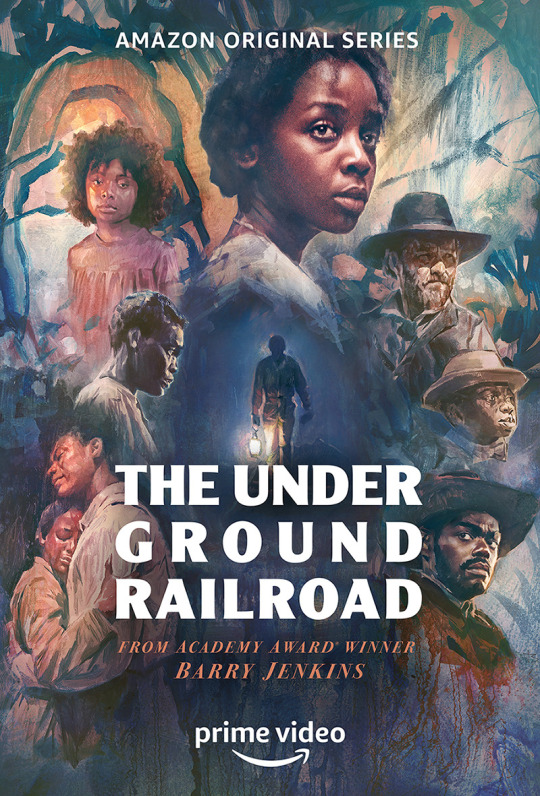
View On WordPress
#Amazon Original#Amazon Prime#Barry Jenkins#Historical fiction#Magical Realism#The Underground Railroad#The Underground Railroad (2021)#TV reviews#TV Show Reviews#tv shows
0 notes
Text
The Real McCoy
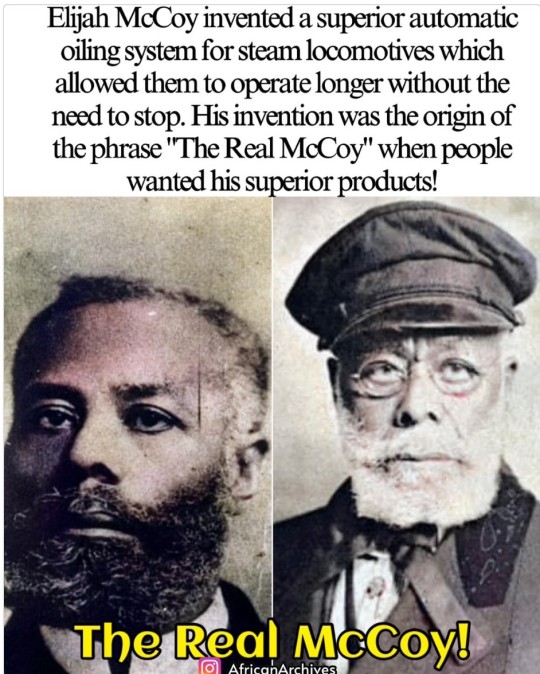
Elijah J. McCoy was born on May 2, 1844, in Colchester, Ontario, Canada, to George and Mildred McCoy.
—They were fugitive slaves who had escaped from Kentucky to Canada via the Underground Railroad. In 1847, the large family returned to the US, settling in Ypsilanti, Michigan.
—Beginning at a young age, Elijah showed a strong interest in mechanics. His parents arranged for him to travel to Scotland at the age of 15 for an apprenticeship in mechanical engineering. He returned home to Michigan after becoming certified as a mechanical engineer.
—Despite his qualifications, he was unable to find work as an engineer in the U.S due to racial barriers;
—He accepted a position as a fireman and oiler for the Michigan Central Railroad. It was in this line of work that he developed his first major inventions. After studying the inefficiencies inherent in the existing system of oiling axles, he invented a lubricating cup that distributed oil evenly over the engine's moving parts. He obtained a patent for this invention, which allowed trains to run continuously for long periods of time without pausing for maintenance.
—McCoy continued to refine his devices, receiving nearly 60 patents over the course of his life. While the majority of his inventions related to lubrication systems, he also developed designs for an ironing board, a lawn sprinkler, and other machines.
—Although McCoy's achievements were recognized in his own time, his name did not appear on the majority of the products that he devised.
—Lacking the capital with which to manufacture his lubricators in large numbers, he typically assigned his patent rights to his employers or sold them to investors. In 1920, toward the end of his life, McCoy formed the Elijah McCoy Manufacturing Company to produce lubricators bearing his name.
—McCoy married Ann Elizabeth Stewart in 1868. She died four years after their marriage. In 1873, McCoy married Mary Eleanor Delaney. In 1922, the McCoys were involved in an automobile accident. Mary died, while Elijah sustained critical injuries from which he never fully recovered.
274 notes
·
View notes
Text

(Pictured above - a map showing the current segmentation of the Burroughs, the People Below's sections of political territory, with annotations showing the leaders of each. Which Burrough do YOU reside over?)
Public Information File 55661: The Molemen/The People Below.
The Office provides this information to the extranormal public in order to educate about our neighbors Below. Let's learn about the Molemen - together!
The Molemen first appeared on the Office's radar in 1965, when one Thaddeus Marsh, an expert in soon-to-be illegal genetic engineering and anatomy manipulation, began to talk to colleagues in the extranormal sciences community about retreating underground. Fearing nuclear annihilation in the Cold War, many of his associates agreed with him.
Using currently-classified anomalous technology, they created a series of self-replicating bunkers deep underground, starting with small rooms that expanded into massive complexes that gradually connected via long tunnels. Railroad systems were established in these tunnels, and by 1971, enough work had been done that Thaddeus Marsh felt confident moving people underground.
The work was quick, but the other scientists, hired workers, and civilians drawn by the promise of safety had not expected Marsh's mental deterioration. All of the personnel who moved underground were trapped and subjected to extranormal genetic and anatomic manipulation to "better adapt" them, in Marsh's belief, to a life underground.
From 1971 to 74, Marsh, now known as the Underking Murmur, ruled with an iron fist. His territory expanded under the lower 48 states, and parts of Canada and Mexico. His madness seemed to grow with his power, kidnapping cavers, miners, and other surface-dwellers to induct them into his army. Developing unimaginably vast factories, he created digging machines capable of moving anomalous amounts of dirt. By 1974, his plan to invade the surface world with these machines became widely known among the People Below.
The organizing body responsible for the incredibly complex logistics of moving so much earth, the Miner's Union, fomented a revolution in the Underground in mid-74. After three months of vicious fighting, the loyalty of the Underking's minions was tested and found wanting. Underking Murmur was deposed, and in its place the Union members created a council. The Underking's territory "balkanized" into 12 loosely-allied "Burroughs" that the Office recognizes as the political authority of the People Below.
With recent diplomatic efforts, the Office for the Preservation of Normalcy has welcomed the People Below to the surface under our Legal Extranormal Persons program.
#office for the preservation of normalcy#documents#maps#molemen#urban fantasy#microfiction#wizardposting
120 notes
·
View notes
Text
Halloween prompts no. 12
Danny kills Darkseid au but not only does he freak out, he is essentially kidnapped by Clockwork and dragged back into the DC universe for a "vacation". When Danny tried to argue the old stopwatch confessed that Dannys core was essentially eating the dark gods energy and he would need to stay in his Phantom form 24/7 to be able to "digest" him. Which gave him a few new things to freak out about. Yay.
Danny was given some new clothes-all glowing black and white of course- and money (where did clockwork get this much cash??) and told to find so.ewhere safe to live in.
Danny went ghost and got changed and started to fly off when clockwork stopped him and told him to behave like a normal human. There are a lot of people in this world with superpowers and while they might look at him strange they would likely ignore him for the most part. But if he started showing off all these cool powers its going to gain unwanted attention. Like another Vlad. Danny shuddered.
As a last parting of wisdom, he tells him not to give out his real name and if anyone asks questions just repeat, "I'm on vacation." then time unfreezed.
So Danny walks out of the alleyway he was in and into the city where he immediately looked for a place to make a underground ice cave to live in. Despite having a crapton of money now (wth clockwork???) He still couldn't get an official apartment due to being fifteen.
Within a few days of just casually going about in Central city he had been approached by "talent agencies" and headhunters offering him jobs as an actor or model and he flusteredly turned them down but was always somehow railroaded into taking a business card. (He wasn't that pretty, surely. All of his fame back home was due to him being a hero...right?)
One particularly insistent guy just wouldn't give up and cornered Danny. It was when he thought he was going to have to break this guys nose to get away that the local hero Flash stepped in and the guy finally backed off.
Danny thanked him and the Flash (who felt clockwork freeze time before and nearly had a panic attack along with Zatanna and Captain Marvel) asked about the weird quantum energy around him and in his panic Danny stupidly confessed to having a magical artifact that makes him immune to time freezes fused into his chest by one of his bad guys.
Which led to him stupidly telling him his name was Phantom, he was a superhero who was on (forced) vacation due to injury-kinda, he wasn't allowed to help out sorry, and he was from another dimension and oh crap he had been truth serum-ed!!! How dare?!
Flash apologized, but after the global time freeze (it was global??) The Justice League was on high alert and the Batman was super paranoid and liked having answers. Unfortunately for this bat guy he was miffed at being drugged and refused to answer anymore questions.
Still, with the disappearance of Darkseid and Apokolips, the global time freeze and now this glowing kid from another dimension? They had to be connected somehow. The league was sure of it. The new gods were freaking out and searching for answers themselves and the speedsters were trying thier best to get this kid to open up to them. After a while with little success they start sending in the Teen Titans and the Young Justice teams in hopes that he'd be more social with people around his own age.
It did not go as planned.
---
People: *telling Phantom that he's beautiful*
Phantom: Is this a trap?
#fanfiction prompts#prompts#halloween prompts#dp x dc#dc x dp#detective comics#the flash#danny phantom#danny fenton#batman#the justice league#justice league#young justice#teen titans#barry allen#wally west#bart allen#up to you#danny is very pretty in this au and ridiculously over powered#he is oblivious to both of these facts because i love a good himbo#i like the idea that the ghosts of the Infinite Realms are sometimes refered to as god eaters cause thats so cool#Phantoms tummy is full of evil god and hes finally having a good time#just chilling in half this fic#and being hit on#he deserves it#as a treat
1K notes
·
View notes
Text
This probably isn't new but it just occurred to me that if sinners can't leave the pride ring, and the exterminator can't kill hellborns, then like 86% of hell has probably never even SEEN the carnage of the extermination.
We don't know how long the extermination go on for, but I feel like the way Adam is, that they're probably pretty quick, like legit a full day if not just one night.
And I can't imagine they BOTHER checking the other rings for escapees, if we're assuming there's nothing but the law stopping sinners from leaving, and THEY assume that's enough.
So there's like, probably a legit underground railroad of sinners trying to get out of pride, like probably at all times, but especially the days and weeks leading up to the extermination.
And I could see so many hellborns taking advantage of that, like life as a sinner cannot be safe or good in the other rings when you have to keep you head down and try to blend in. They're probably like, legit selling their souls for it. Which is what makes me think sinner can physically leave. (Or, can sinners tell their souls to hellborns or only other sinners?)
It's trading one hell for another. Literally.
And they're immortal. They'd get noticed if they didn't stay hidden, if they're contract wasn't like, passed down parent to child in a same house hold told to keep it quiet, because rtheye equally not auposed to have a sinner in their hosue. They couldn't lead any better of an immortal life.
Could you then imagine them trying to get back to pride just to be their own person again even if it means they might get murdered every year.
And getting back to 86% of hell's residence that have never seen it up close.
They've got to be buying into some kind of propaganda about it.
"Oh sinners are immortal and more powerful than us. They should be thinnes out or theyre rise up and take over hell" kinda thing, like the legit same argument heaven has for the genocide.
and since most of them never MEET sinners to empathize with, and the way they're encouraged to put down imps as children, they'd be it easy to convince.
But I feel like some Hellhounds and Imps would DEFINITELY be helping sinners escape pride.
I bet they help hide the ones who couldn't get out because I can't imagine sinners just go about their business as the extermination starts.
The days leading up there'd be so much going on as sinners try to get somewhere safe, in their own city, or places outside it or in other cities. The hours leading up to it, the streets have to be so quiet you'd think it already happened.
And because the sinners HIDE, the angels MUST be knocking down doors and raiding basement in house and business across pride.
I wouldn't be surprised if hellhounds and imps get killed, and the angels just don't see consequences because it's hellhounds and imps.
Like it's really actually that horrible.
Very very glad the shows plot is ending it.
[Continuation here]
#hazbin hotel meta#hazbin hotel theory#hellava boss#hellava boss meta#hellava boss theory#charlie hazbin hotel#blitzo helluva boss#blitzo#moxie helluva boss#loona helluva boss#lucifer magne#beelzebub helluva boss#vox hazbin hotel#adam hazbin hotel#sera hazbin hotel#lilith hazbin hotel#vaggie hazbin hotel#lute hazbin hotel#hazbin hotel#husker hazbin hotel#angel dust hazbin hotel
92 notes
·
View notes
Text
Me: BBC Merlin is my favorite show of all time. Longest standing fandom I have ever been in. I am borderline obsessed. These are my emotional support characters
Also me:
“Arthur is just Ken”
“it genuinely angers me that the only people Merlin has killed are sorcerers or sorcerer accomplices driven to ‘evil’ by systemic oppression and genocide but has never really killed any of the people in power perpetrating such a genocide”
AKAB “All Knights Are Bad” sure y’all get to not oppress the poor but you’re also upholding a genocide so FUCK that
Arthur, I love you, but you could have been replaced with literally any of the knights and the prophecy would probably have come sooner. The only reason you’re the once and future king is because you are next in line for the throne so you becoming king wouldn’t cause a war and you have the “super rare” attribute of being convinced maybe genocide and starving people is bad. But only with a decade of convincing
Merlin why aren’t you using your powers to create a Camelot Underground Railroad, my dude
Kilgharagh, I know you are just a plot device the writers used to allow for there to be more seasons than necessary, but I would wear your skin for my boots if I could.
Merlin the revolutionary WHEN???? How DARE you take that from me. How DARE you make Merlin be passive to a genocide and just play bodyguard for 5 seasons and then kill off his fucking charge before any TRUE systemic change could happen. I will NEVER get over this
#the fact that I have so many complaints is high praise#can you tell I think about this show all the time#also the knights are my favorite and I love them but if I was a real person in universe I would be strongly AKAB#merlin#bbc merlin#merlin bbc#merlin critical
57 notes
·
View notes
Note
What's an obscure piece of media you wish more people knew about?
hi! I'm honestly so bad at judging what's obscure and what's not. In high school, I genuinely thought my music taste was alternative because I was the only person in my group of friends who listened to the Jonas Brothers. so idk if this is obscure media but it's media I love that I wish I could talk to people more about:
Some Girls (2012-14) - this sitcom series about 4 high school besties who live around the same housing estate was EVERYTHING to me. think Derry Girls/Sex Education but in the early 2010s with working class poc. I still quote this show at least once a week and miss it dearly even tho it ended exactly as it should!!
While The Men Are Away (2023-?) - lesbian period drama comedy about a bunch of Australian lesbians on the WW2 homefront in regional Australia. Beautifully horny show that also has STUNNING representation of immigrant and Indigenous experiences of the time.
Clarice (2020) - silence of the lambs sequel series that follows Clarice Sterling on a case 2 years after her encounter with Hannibal Lector. so sad this was cancelled but it's still a great season of tv!
The Underground Railroad (2021) - limited series on Amazon Prime about the Underground Railroad. Tw for literally everything, BUT it's directed by Moonlight director Barry Jenkins and his hands down some of the most beautiful TV I've ever seen.
The Silent Sea (2020) - limited series on Netflix about some astronauts sent to a mining station on the moon where something has infected all the crew.
The OA (2016-18) - difficult to describe this show but it's everything to me. theeeeee show about multiverses. Ahead of its time, gone too soon 💔
But 2 genuinely obscure pieces of media I think people should watch, especially rn, are Salt of this Sea (a film about a Palestinian-American woman heisting an Israeli bank to get her grandfather's money back) and the 2019 sci-fi short film In Vitro about an elderly Palestinian woman in an underground bunker trying to pass on why she's here to another Palestinian woman but neither can remember.
76 notes
·
View notes
Note
What do you think of GHMs more "Mainstream" titles such as LC, SoTD and NMH3 compared against their more underground works like Killer7, Silver Case and NMH1. I find the latter has a sense of mystique and weirdness that's missing from the former when the studio seemed pigeon-holed in a brand of "Sex, Violence and quirky"
I've been meaning to write about this here, so good question! I gave it a lot of thought after finding a JPN copy of Killer Is Dead and seeing this within the box;

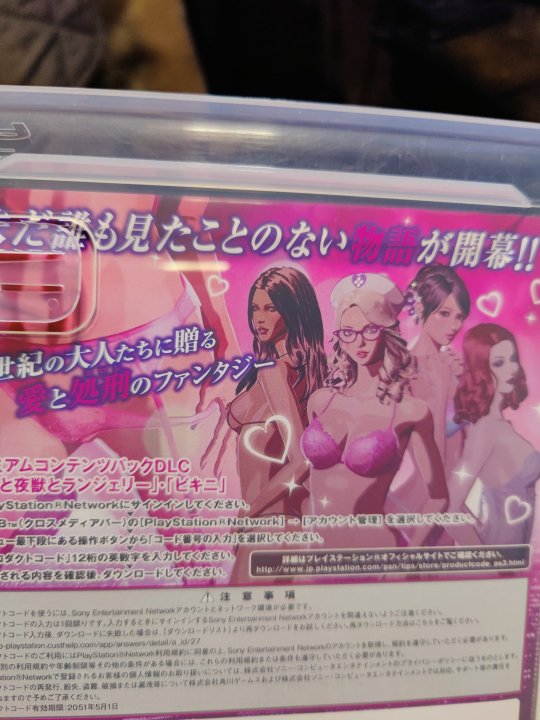
Here's a quote of Suda reflecting on the production of said game;

Suda was not interested in eroticism when it came to his company's games. However, the more mainstream games GHM made (without his direction) were full of instances that were little more than eye candy. Sex appeal for the sake of it. And much of that was against Suda's will;

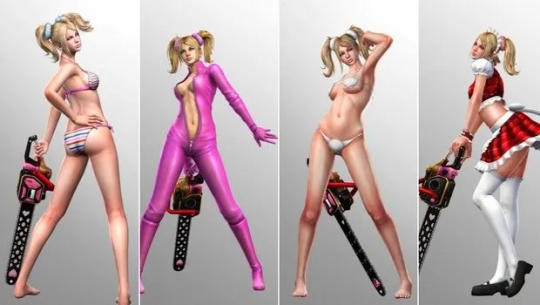
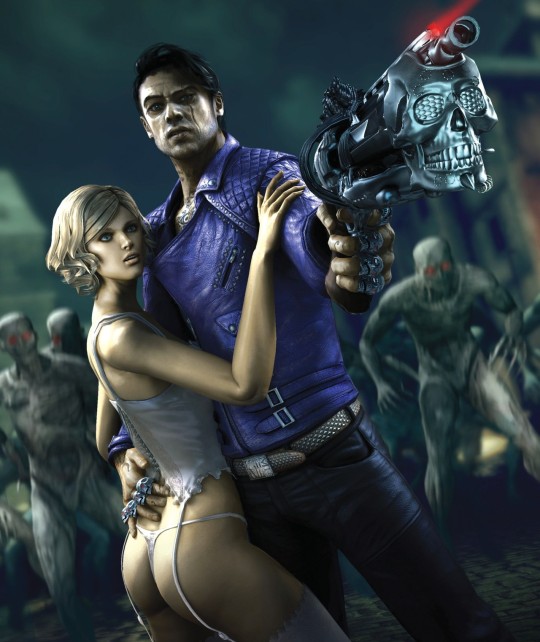
Paula running around in a thong (and even tits out a couple times if you played the NA version) throughout Shadows of the Damned also reminds me of Tim Rogers recalling his time working at Grasshopper as a designer in the late 2000s. He sat in a lot of meetings with Suda talking to EA and mentioned a time Suda talked about a save function idea he thought of while reflecting on Travis always using a toilet to save in the NMH games.
An early idea was Garcia going to bed with a woman every time he had to save. This was likely when the game was still going to be open world-ish and Garcia was single. From how Tim Rogers talked about this, it was pretty much the only idea Suda had that EA actually showed interest in. Obviously this idea never panned out, instead saving being delegated to a little demon that poops to signify a saved game. Funny that it connects to NMH's toilet save function in that way.
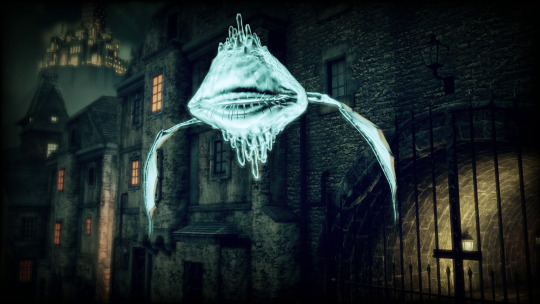


Something else worth bringing up would be the "gigolo missions" from Killer Is Dead. This also derived from a concept Suda had for Shadows of the Damned where Garcia was gonna take girls out on dates, bring flowers, and it'd actually be cute and romantic. At least, from how he described it.
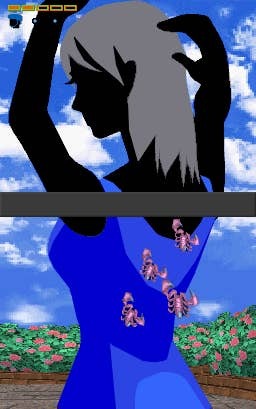

(These screenshots are from Feel the Magic, a DS game where you played mini-games as you tried to win the heart of a girl throughout the story)
This idea was repurposed for Killer Is Dead, but, according to Suda, the sexual aspects of it were conjured up by Hideyuki Shin, the game's director. Therefore, it devolved into x-ray glasses, staring at boobs, and giving gifts to a robot that repeated animations. A cannibalization of the original concept.
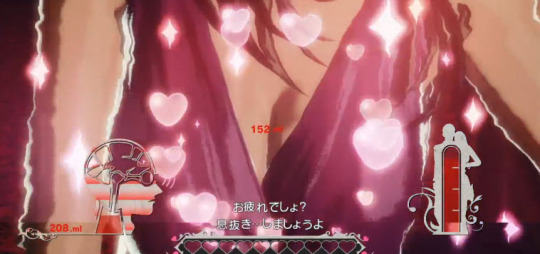
Suda seemed afraid of Grasshopper's reputation being mutated into an identity he didn't consent to. Sex appeal is not something he really thinks about when it comes to making games. It's not his style;
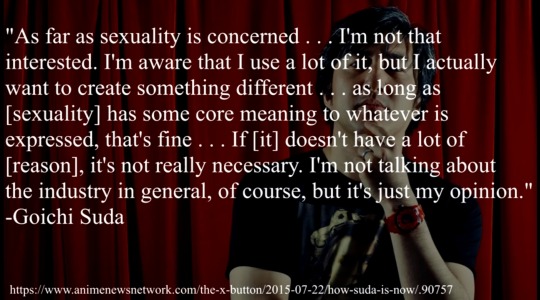
The only times Suda has shown sexuality in the games he directed is when it's discomforting or deeply disturbing, almost never for eye candy.
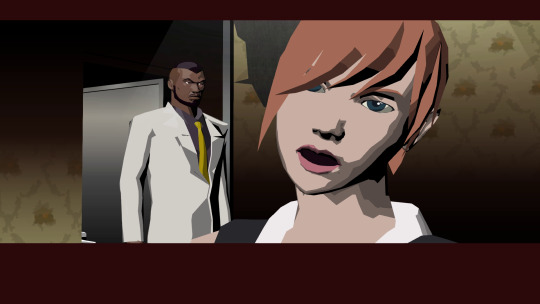

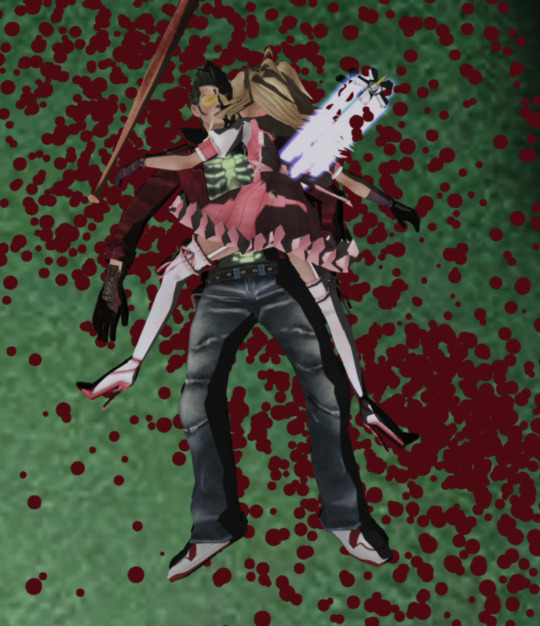
I still appreciate games like Shadows of the Damned, Killer Is Dead, and Lollipop Chainsaw. As much as this era of GHM was railroaded to chasing some mainstream trends and trying too hard to be quirky, they still had unique aspects that help them stand out above other games of the same subgenre. But I can't help but notice a fissure between these games and the ones he actually directed. The nuance, mystery, and thought-provoking stories are most prominent when he's the one directing.
I'm not going to fault people for liking eroticism and such in video games. I've played plenty of horny games too, and there's obviously an appeal there. But anyone still expecting that from Suda is barking up the wrong tree. Looking at how he's been handling everything since 2018 makes it even sadder when you reflect how these publishers tried cramming Grasshopper Manufacture into this box they didn't want to be in.
One last thing I have to retort, though. I don't lump No More Heroes 3 with the quirky "mainstream" games the way you did in the question. Sure, NMH3 definitely went for a more mainstream marketing plan and the game got super silly at times, but it still has an interesting narrative with a ton of nuance. Way more than any GHM game between 2010-2016. Hence my 4+ hour long analysis of the game;
youtube
Many people even rejected this game outright because the eroticism and scantily-clad female cast was mostly absent. This was likely expectations they built after experiencing games like NMH2, SotD, LC, etc.
Speaking a bit more on the sense of eroticism, it's funny to think how that was admittedly present in NMH1, obnoxiously expanded upon in NMH2, and then mostly done away with in NMH3. Going as far as turning Naomi--and her balloon tits--into a goddamn tree!

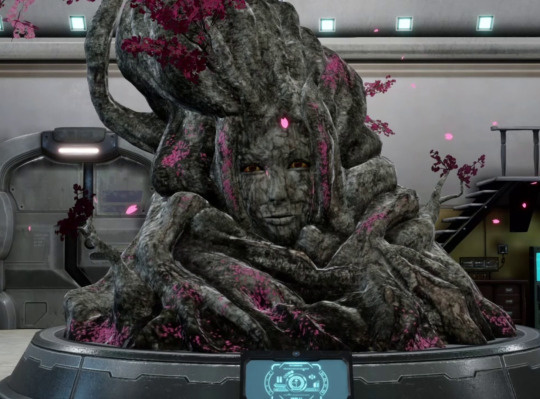
However, I don't believe Suda turned Naomi into a tree for the sole purpose of removing her sex appeal. I believe this just further accentuates how that aspect is not something he's interested in or finds important for the game itself. He likely didn't even think of it that way, but instead "Hey, she should be a tree now."
And then there's Kimmy, whose death was not only a very harrowing moment in the game, it was also depicted in a sexual manner. Similar to Bad Girl's death in the original NMH. Note the motions and angles in her death scene.
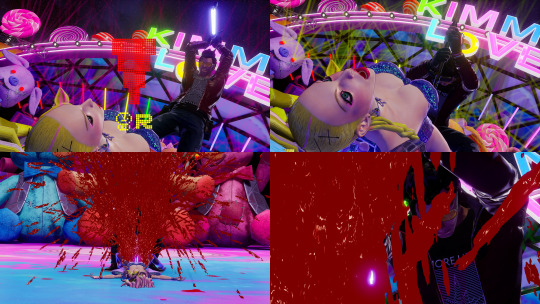
Like I said, this rather disturbing sense of sexuality is more Suda's vibe. And I'm happy to see he hasn't lost that edge, so many years later. Anyway, thanks for the question! I had a lot of fun writing out this answer.
#suda51#grasshopper manufacture#killer7#nmh3#no more heroes#no more heroes 3#lollipop chainsaw#shadows of the damned#killer is dead#the silver case
103 notes
·
View notes
Note
AITA for being frustrated about my current campaign?
I (Minor) am in a longform TTRPG storyline where me and my friends (mostly adults) run campaigns mostly related to our OCs and storylines.
I have ran the previous two to a pretty decent audience, but this current one ran by the people (mainly 1 guy and 1 girl) who ran the very first campaign is... rubbing me the wrong way.
see, they basically only do dialogue, and there are next to no narration and techniquye, which is awkward for a discord text ran campaign. I am an aspiring writer, and have noticed they use no technique, style or clear tone in any sort of implied (rather said, in recent times that a sccene of dialogue was set awhile in the past rather than saying so in narration, they clarified ooc to say).
it's all tell, and not show, which is awkward for a campaign thats meant to be comedy but implied the absolute opposite.
the TTRPG world we've all built has established mind alteration and control as horror. they used this in a comedy way, and got veyr passive agressive when I had my character who has been traumatised (and gone through therapy about it too) over prior events, react accordingly.
the setting is a cold, dark underground and the antagonists come of sadistic and cruel forcing the characters through their trial for... no reaosn (it is clear what they are thanks to one dm's player character being of the same altered species which is why they're here - investigating weird sightings; the answer's solved) as they are unknown and omnipotent speaking through loudspeakers.
they want us to do slapstick with this. and dialogue. and half assed descriptions of "It's... completely empty. Anything that was supposed to be docked here is gone. Just empty space in front of empty docks. You're gonna have to roll real low if you wanna make this place livable."
similarly, one of the DMs on another note has asked me to tone down my explicitly more fun light character, who toys with words and needlessly quotes shakespeare and is melodramatic, who plays with puns, and has complained that they "always win the argument." when, they never really get into arguments?
furthermore, the runners of the campaign have dropped off managing the campaign for months at a time without notice, leaving me and other people just. unable to use our characters.
i have longform character arcs planned and they're acticely hindering my enjoyment and participation by a sheer lack of effort, style or attempt at guiding us on their intended path and instead railroading.
so, tumblr, am I being an irrational, hormonal kid (barely), or am I just pretentious with my writing style of wanting to describe the setting and imply mood?
TLDR: current campaign is at a snails pace, wants to be comedy but is really saying otherwise with what little we're given as readers to their written discord dialogue, and DMs have ignored characterisation and history of said characters.
What are these acronyms?
83 notes
·
View notes
Text
Brozone CAH
Bruce drew the black card, laughing as he read it.
“What did Vin Diesel eat for dinner?” Bruce said, smiling as he set the card down in the middle of the table.
The other bros made noises while they tried to decide what cards to play.
After a minute or two, they all put a card down, passing them to Bruce.
Bruce took the cards, gave them a little shuffle before laying them out next to the black card.
“What did Vin Diesel eat for dinner? He ate Sean Connery. What did Vin Diesel eat for dinner? Vin Diesel ate chainsaws for hands for dinner, pretty sure that’s cannibalism. What did Vin Diesel eat for dinner? The gays? Looks like Floyd’s getting eaten and I swear if this is your card. What did Vin Diesel eat for dinner? A sea of troubles. Sounds salty….Alright who had the gays?” Bruce said, holding up the white card with ‘the gays’ on it.
“I’ll take that, thank you.” John Dory said, reaching over and grabbing the black card.
“You want me to get eaten, John?” Floyd said in a fake sad voice, pouting a little.
“The card just said the gays, it didn’t say all the gays. You should be safe. But also, who wouldn’t want to get eaten by Vin Diesel?” John said while drawing another white card.
“John, your bisexual is showing.” Branch joked as he drew the next black card.
"In Michael Jackson's final moments, he thought about blank. This should be good." Branch said, setting the card down in the middle of the table before taking a drink of his beer.
"Fuck you, my bisexual isn't doing shit." JD grumbled as he looked through his cards.
The rest of the bros laughed as they tried to pick their cards.
Once everyone put their cards down, Branch gave them a quick shuffle.
"In Michael Jackson's final moments, he thought about a sad handjob. Very mature. In Michael Jackson's final moments, he thought about becoming a blueberry. Weird thing to think about while dying but ok. In Michael Jackson's final moments, he thought about goblins. Yeah probably of the crotch variety. And last but not least, in Michael Jackson's final moments, he thought about the underground railroad. Again, a weird thing to think about while dying. Who had goblins?" Branch said, holding up the black card.
Clay held up a hand while he took a swig of his beer with the other.
Branch handed the black card over to Clay, rolling his eyes.
"Fuck yeah, goblins for the win." Clay said cockily.
"That's like your third point, you ain't winning shit." Floyd teased, taking a sip of his wine.
#trolls#brozone#trolls john dory#trolls floyd#trolls bruce#branch trolls#trolls clay#funny#trolls cah#brozone cah
33 notes
·
View notes
Text



From ‘Underground Railroad’ Quilt Weaves Black Liberation History:
The African American Quilt Circle of San Antonio is preserving personal, political, and historical narratives through the ancestral practice of quiltmaking.
“There’s a determination not to tell the true history, because no one wants to admit to the evilness of the people we celebrate as heroes,” said Deborah Moore Harris, the president of the quilt circle. The group’s latest body of work is currently on view at the Carver Community Cultural Center Gallery through December 16.
Moore Harris is an artist, retired Army veteran and one of the quilt circle’s four founding members. She works part-time at a craft store. About 20 years ago, she decided to make her first quilt after watching an episode of The Carol Duvall Show, an arts and crafts program that ran on HGTV from 1994 through the early 2000s. The quilt was a gift for her mother and stitched together the genealogical details of her ancestral tree.
“It is definitely not straight, but it is colorful and tells the story of my family.”
Read more on the Texas Observer.
262 notes
·
View notes
Photo



Introducing my Amell oc-turned-npc in the Dragon Age series~ A summary about him in my canon through the games:
Origins: Firstborn from Revkah Amell, a noble family from Kirkwall. Was taken to Kinloch Hold in Ferelden when he was a kid to separate him from his family, never met his younger siblings or saw his mother ever again. Grew up at the Circle tower and made friends among the very few Loyalists mages, sharing chants with them which made him be seen very Andrastian and pro-chantry to others. By this time, he was well aware of Cullen’s, a young templar, crush on him, and Amell who already had a mischivous personality, always decided to tease him in response, though it never developed in anything more. Once he succeded his Harrowing and turned into an Enchanter, Amell aided Jowan in his attempt to escape, but was lied to by his friend, resulting in him helping a blood mage to leave the Circle. Because of this, Amell didn’t join the Wardens and was punished with isolation during some time, in which he specialized in shapeshifting magic in secret, since he was taught by a supossed demon called “Mouse” during his time in the Fade, in his Harrowing. He then mimicked the mice, his only companions during that time, escaping the tower’s cat, and resulting in his distaste for them since then. By the time Uldred’s conspiracy broke and the Circle was rampant with abominations and blood mages during the Blight, Amell was one of the few that stayed with Wynne and protected the children and other injured mages. Though he never showed any kind of ill feelings towards templars more than the ocassional bad individuals before, the templar’s actions about abandoning the mages to the abomination inside the tower made Amell start to grow angry and distrustful at the organization for the first time, rivalizing Cullen’s requests about annuling all the Circle.
DA2: Some time after the fifth Blight, Amell was sent with others to The Gallows, the Circle of Kirkwall, his born city. During the years the rebellion of mages started its upbringing, Amell was promoted to Senior Enchanter and assisted First Enchanter Orsino, but also become known as a Circle mage turned sympathizer with the code name “Mouse” in the Underground Mage Railroad, since he helped mages to escape The Gallows from the inside using his shapeshifting magic to avoid the templars vigilance. He also met Hawke, his second cousin, during these years both in and out The Gallows, as he always came back to avoid being framed an apostate. Amell become more radicalized and angry as the years passed while witnessing the abuse the mages suffered at templars’ hands at Kirkwall, but kept a low and solo profile to not risk his envolvement on the Railroad and only antagoned Cullen’s direct threats if necessary. This was, until Knight-Commander Meredith and First Enchanter Orsino declared their open war in the last years, and blood mages and templars persecution become the norm, resulting in the Chantry blown up incident, that he started to realize the breaking point the city reached and stepped down from supporting the radicalized side. When both Meredith and Orsino perished by their own actions and the war started, Amell was forced to become an apostate as the Circles fell.
Inquisition: Tracked down and captured by Cassandra Pentaghast in her search of Hawke’s location, Amell reveals to have no knowledge of this or any of his family situation once Hawke disappears from Kirkwall and so, no way of being helpful at all to her cause. Cassandra probes this to be not true then when she forces him to join the Inquisition forces in need of personnel, and in exchange she wouldn’t execute him for apostate and aid provider in the mage rebellion. Accepting this, Amell is tasked to talk with Cullen, an “old friend” and recruit him for the Inquisition forces as well, alluding to their old relationship, even previous to Kirkwall. While Cullen is given the Commander role, Amell gains the Advisor title in Arcane instruction and coordinates magical reasearchs for the Inquisition from the war table. Coming back to his more moderate reasoning about the templar-mage conflict and his beliefs of individual worth before organization judgment, he also gives refuge to the few rebel mages that decide to follow him instead as he advocates for mages rights as free individuals and their general welfare. Though he may clash with Cullen in these matters from time to time, they work together to mend the fractured relationship between the templars and mages in their improsived alliance, as well as their own personal relationship too.
#Dragon Age#Da Origins#da2#Da Inquisition#Dragon Age Amell#Male Amell#Daylen Amell#Advisor Amell#Da oc#cullen rutherford#Dragon age art#Here is my boy#basically he popped in my mind one day while I was going through the mage origin and it scalated from there honestly#Please dont mind me I fell in the da hell
112 notes
·
View notes
Text

Just posting some fancy 1920s characters I made to mess around with ☕✨
(aka things that happen when I read Wodehouse, Lackadaisy and binge Downton Abbey)
From left to right: Priya, Freddie, Matthew, Arthur & Marion
1928
Lord Dalham's son has succumbed to illness and the next heir to his title, his nephew Frederick Barlow, a solicitor, is to return to England after spending the last two years in India.
"Freddie", isn't quite the reserved, serious man that everyone remembered upon return; because they are in fact, Frederick's unruly twin that was travelling by his side to be engaged to an English officer.
After their brother's unexpected death, Freddie assumed his identity, recruiting the help of Frederick's former valet, one Matthew Halkett.
Through gentlemen's clubs, fancy country houses, speakeasies and gambling pits, dog shows and county fairs, Freddie discovers alarming and conflicting information regarding their twin, as well as people who seem to have curious ties to him.
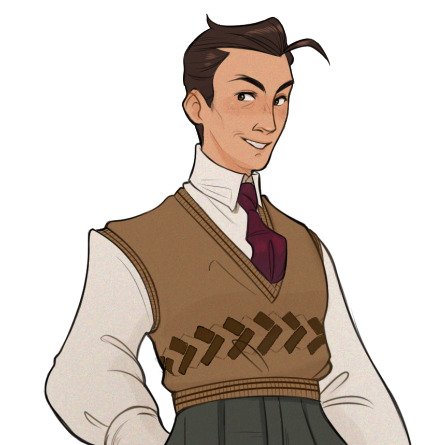
Freddie Barlow (28)
Despite being born in the upper classes and having the privileges that come with this, Freddie never quite found their calling in life, nor were they considered a particularly graceful aristocrat; not being the one for sports like tennis, or the arts, desperately failing at music and painting.
They would have liked to pursue acting, but that option was of course, off the table. They were supposed to be a socialite like their mother, and their acting skills were required to put on a mask and pull on strings. That seemed to keep everyone pleased until in an effort to protect their best friend from a predatory suitor, Freddie allowed scandal to soil their name and was sent to India to get married, accompanied by their twin, Frederick.
After Frederick's death in a railroad "accident", Freddie discovers a plot against their family, and assumes his identity upon arriving in England, after a 2-year absence. Their alter ego is assumed to still be in India and married to an English officer.
Freddie is constantly discovering alarming and conflicting information regarding their twin and bears guilt, doubt, and identity issues over their actions.
(Freddie is afab & non-binary/genderfluid by today's standards, all pronouns apply but in the context of the story, Freddie leans towards masculine terms)
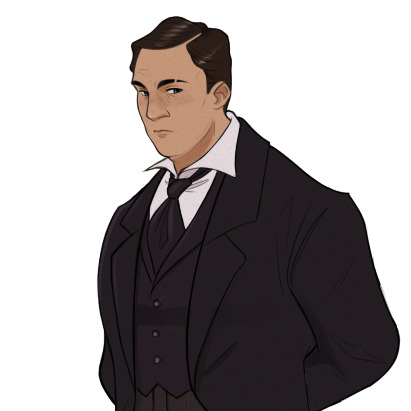
Matthew Halkett (30)
Matthew Halkett was Frederick's former valet, who was let go before the twins' trip to India.
Halkett grew up into poverty and was a thief and an underground boxer as a youth, before turning his life around in his teens. He dedicated his life to service, when his uncle, butler at Lord Dalham's big estate, helped him get into service as a footman. He soon found he has a particularly keen eye for detail, and a strong work ethic that made him shine amongst staff. He also served in the Great War before his employment at the Barlow household.
Upon receiving news of his potential title as heir to his uncle, Frederick required a valet, and when the two met at Lord Dalham's estate the offer was made.
As Frederick's valet Halkett knew most of the secrets of the household, including Freddie's. Due to an unjustly blamed incident of theft, Frederick fired him with no reference which left him in a rather unsatisfactory position, under the employment of an old bubbling arrogant Colonel.
His previous position also makes him a target of Frederick's enemies after his death. He is the first ally Freddie seeks out upon returning to England, and is offered, once again, the position of the valet on their side instead.

Priya Curtis (21)
The youngest daughter of middle class merchants, Priya Curtis is an sweet and elegant young lady of British-Indian heritage who seems to have followed Freddie all the way on his trip back to England. Or more like, she seems to think she's following Frederick.
The reason? Why, revenge, of course.
If they get past that misunderstanding, Priya and Freddie might discover they are connected by something of a familial nature.
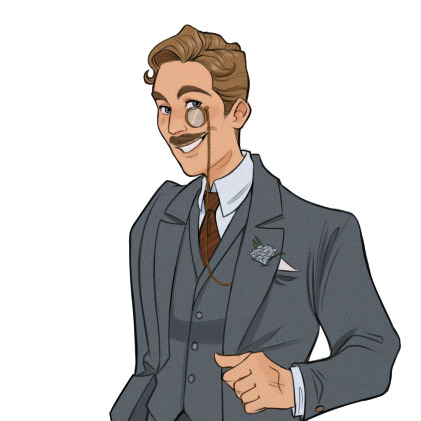
Arthur Pennington (28)
Arthur Pennington is the son of an English earl & an American heiress, and Frederick's friend from their university days in Oxford. Despite his wealth, he also studied law but remains rather unworldly and naive due to a rather sheltered lifestyle. He makes up with his infectious energy, friendliness, and unending loyalty, and he's eager to recount old stories to Freddie, initially not realizing he's not talking to their twin.
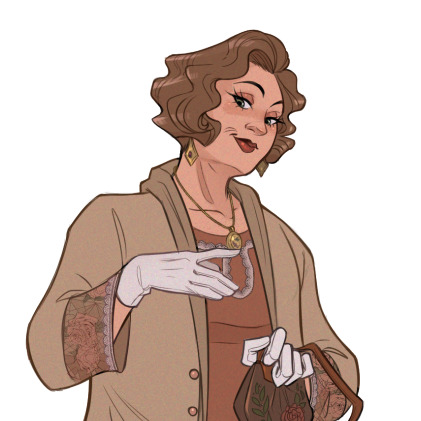
Marion Ellis (36)
A Renaissance lady; writer, poet, and predominantly a journalist, she spent many good years in Paris and Montmartre, where her fiancé, John, awaits her return. An extremely romantic soul with a love for the arts and a social butterfly, Marion is well aware of the ins and outs of high society and has written under a nickname for ladies' magazines. She is an acquaintance of Freddie's lord-uncle, and apparently, had some mysterious ties to Frederick.
#original characters#ocs#character lineup#1920s characters#my week's been hellish and this has been in my drafts for 2 weeks#will report as soon as I get 50 hours of sleep#i have so much trouble just being indulgent and ranting about ocs but I also want to sorry#nnobodiusart
63 notes
·
View notes
Text
MOGAI BHM- Belated Day 17!
happy BHM! today i’m going to be talking about Black influences on various genres of music! obviously i won’t be able to cover every music genre in this post so im just going to do the ones i know most about!
Spirituals-

[Image ID: A black-and-white drawing of a gathering of Black people in a small, crowded room. At the front of the room, a man dressed in a tuxedo is gesturing grandly at a podium with two other men standing beside him. The rest of the people in the room are all dressed formally and in various positions- some sitting, some bowing, some kneeling, and some standing with their arms raised in the air. End ID.]
Cultures from across the continent of Africa placed huge emphasis on music. Music in many African cultures was very rhythmic, enthusiastic, and depended on participation from entire gatherings of people, not just one person. When people began to be kidnapped for the slave trade, that connection to their specific culture was often lost- but spirituals became a way of reviving that.
Derived from the term ‘spiritual song’ from the Bible, a spiritual is a religious folksong that expressed deep religious themes, and usually themes of resisting oppression in the context of slavery. In the decades leading up to the abolition of slavery in America, spirituals became a very popular musical form amongst slaves at plantations. While their white masters and white populations in general hated the music form because it represented Black freedom and resistance, and therefore gatherings to sing this kind of music were banned, many slaves found ways to still sing spirituals. Spirituals involved call-and-response singing, clapping, and stopping amongst an audience.
Starting in the 1700s, slaves began to gather informally in what were known as “praise houses”. They also held outdoor meetings called ‘brush arbor meetings’. In these gatherings, they would dance, sing, and play music together, as well as pray. At these meetings, they sang ‘corn ditties’, which developed into spirituals. Spirituals developed as a way of maintaining African musical culture in America, uniting against oppression, building hope for a better future, singing praise in a uniquely Black Christian way- and of actually building roads to freedom.
Spirituals were not just used as a way show praise- they were often codes in relation to methods of escaping slavery like the Underground Railroad. Harriet Tubman herself used spirituals like “Go down, Moses” and probably “I got my ticket” to identify herself to slaves seeking escape. Spirituals and their lyrics were often codes of escape for slaves- in this way, spirituals were not just an outlet of rage and pain over oppression, they were a way to actually physically escape it. Other spirituals like “Wade in the Water”, “Swing Low Sweet Chariot”, and “The Gospel Train” spoke about and directly referred to escape methods of the Underground Railroad.
In the 1860s and 1870s, two groups formed- first the Fisk Jubilee Singers (from Fisk University, an HBCU), and then the Hampton Singers, both of whom gained international following for their singing and performing of spirituals. Since then, spirituals have grown as a genre, and have played a part in the development of another major music genre- gospel.
Gospel-

[Image ID: A black-and-white photograph of a group of six Black women. They are standing in two rows of three. Most are wearing fancy white blouses and a wide-brimmed hat, but one is wearing a plaid shirt. They are all holding books and looking at them as they sing. End ID.]
Although early gospel music centered mainly around white churches, it has an undeniably rich place in Black musical and religious history. In the late 1800s and early 1900s, it began to be sung and used more in Black churches. Gospel music as a form, developed from hymns, sacred songs, and other religious musical genres, including spirituals, and was a form of religious music that had one key distinguishing component- church choirs.
Church choirs had long been staples across churches, but especially Black Churches. In Black Churches, choirs were opportunities for people to express their pain through movement and song, as was typical for Black church services at the time. Church choirs were a perfect avenue for the spread and popularization of gospel music within Black Churches.
In the 1930s, a man named Thomas A. Dorsey became known as “the Father of Gospel Music” when he founded a publishing house for Black gospel musicians. He helped push Black gospel music into the American mainstream, and since then, gospel has become a wildly popular musical genre, especially within Black communities.
Hip Hop and Rap-

[Image ID: A black-and-white photograph of people in an outdoor area enclosed by a tall chain-link fence. There are groups of people wandering in the background, and in the foreground, five Black men are gathered around a cluster of tables that are cluttered with musical turntables, fans, papers, wires, and other various objects. One man is crouched in front of the tables and the other four are standing around them. End ID.]
Hip Hop music and rap music developed simultaneously during the 1970s in the Bronx, part of New York City. Black, Latino, and Caribbean communities would hold events known as ‘block parties’, where people gathered as a DJ played music like soul and funk. These events were collaborations between Black and Latino people living in New York City.
At these block parties, some people began to experiment with different types of rhythms and beats. It was common for DJs and performers to play around with various techniques like beatboxing, beat breaks, percussive sounds, scratching, and turntable techniques. This experimentation led to the developing sounds of hip hop and rap. The two genres, characterized by strong rhythmic beats and rapping tracks, began to take hold. A decade later, hip hop was a thriving musical genre.
The first hip hop record released was “Rapper’s Delight” by the Sugarhill Gang in 1979. Since then, hip hop and rap have become some of the dominant musical genres in America. They have produced many, many sub-genres, like trap, nu metal, and grime. These genres have expanded to include different lyrical styles, drum kits, and lyrical contents- all owing to the collaboration between Black and Latino musical artists in the 1970s.
Hip hop and rap have had a huge impact on American, especially Black American, culture. They have helped popularize different combinations of jazz, soul, and hip hop, breakdancing, beatboxing, and other musical styles and techniques. Many hip hop and rap artists have deepened the meaning of the genre by using their lyrics as an expression of yearning for societal liberation, and challenging the systems that be with raw, honest lyrics has become a staple of many areas of rap and hip hop.
Black Influence on Rock’N’Roll-

[Image ID: A black-and-white photograph of Sister Rosetta Tharpe, a heavier Black woman with short hair. In the photo, she is wearing a large fancy dress with very puffy sleeves and a tiny bow, and is smiling widely as she plays guitar at a microphone on stage. End ID.]
Although the development and popularization of rock’n’roll is usually attributed to Elvis Presley, that is simply not historically accurate. Rock’n’roll began to develop in the late 1940s and throughout the 1950s- and it developed out of southern Black musical genres, namely blues music, which proliferated during the Harlem Renaissance and spread from the South. Blues evolved into the famous R&B (rhythm and blues) genre, which evolved into rock’n’roll. A lot of rock’n’roll’s sound also owes itself to the rhythmic patterns of much West African music.
In the 1940s and 50s, blues artists began experimenting and developing the blues sound into what we now know as rock’n’roll. Taking inspiration from other musical genres like country (which has also been heavily influenced by Black people). Sister Rosetta Tharpe was a Black woman who started out as a blues singer. She was a self-taught guitarist, and through her work on developing the sounds of the guitar she played, she pretty much singlehandedly set the tone for the guitar sounds that defined rock’n’roll- her style and influence directly inspired and impacted Elvis Presley.
When rock’n’roll first developed, the genre was pretty much exclusively occupied by Black artists from the likes of Ike Turner and Bo Diddley to Little Richard and Chuck Berry. Black women have also had a huge impact on the genre of rock’n’roll. From Sister Rosetta Tharpe herself, to the all-Black girl group “The Shirelles”, Merry Clayton, and Tina Turner herself. Rock’n’roll has from its birth been built and defined by Black artists, and Black rock’n’roll has heavily influenced music by some of the most famous rock’n’roll groups of all time, like the Beatles and the Rolling Stones.
Odetta, Jimi Hendrix, Prince, all Black rock’n’roll artists who have left an invaluable footprint on music and history. Other incredible Black artists who shaped the genre include Odetta, a Black woman who experimented mixing blues, jazz, and folk music and sang with Martin Luther King Jr. at the famous 1963 March on Washington, Martha and the Vandellas, whose music was a call for solidarity, and the Supremes, arguably one of the most iconic, influential all-female musical groups not just of rock’n’roll, but of all time.
Black Influence on Country Music-

[Image ID: A black-and-white photograph of Charley Pride. He is a Black man with a small afro, and he’s wearing a patterned suit jacket over a white collared shirt and strumming the guitar as he stands by a microphone, smiling. End ID.]
Country music is one of the most popular, well-known musical genres of all time- and it developed in the 1920s as a blend from several other genres- the two main ones being blues and folk songs, both of which originated as Black musical genres. Spirituals were the first folk songs of America, and they defined the roots of the folk musical genre. Blues music developed on Deep South plantations and was a popular musical genre amongst enslaved populations in the South.
Jimmie Rodgers is a white man who is often hailed as the “Father of Country Music”- but he learned everything he knew from Black workers with whom he worked at a railroad track. They taught him how to play guitar and banjo, influenced the musical style of yodeling which he popularized, and taught him falsetto notes and styles. Hank Williams, another white figure hailed as a key builder and trailblazer in country music, also learned his musical style from another Black musician named Rufus “Tee Tot” Payne.
DeFord Bailey was a Black man who popularized the usage of the harmonica in blues and country music. He was the first country artist to be recorded in Nashville, and one of the most popular regular performers at the Grande Ole Opry, part of a popular Nashville radio station.
Two of the most defining instruments of the country genre are the banjo and the “Euphonica” (large acoustic guitar). Both of these instruments were invented by Black people. The banjo was invented by enslaved Black people in the South, inspired by some West African musical traditions, and the “Euphonica” as it was called, was developed by a Black man named Robert Flemming, Jr. Early Black artists like Charley Pride were Black staples of the genre.
Today, country music is filled with Black artists making a difference- from Kane Brown and Jimmie Allen, to Darius Rucker and Mickey Guyton, to BRELAND and Tiera Kennedy- country as a musical genre has always had strong roots in Black music, Black resistance, and Black pride.
Black Influence on Alternative/Grunge Music-

[Image ID: A color photograph of Tina Bell. She is a Black woman who is wearing a messily tousled blonde wig and a black leather jacket. She is smiling widely as she writes on poster boards with a black permanent marker. End ID.]
Alternative and grunge music developed as a blend of various rock genres, like punk. The distinct sound of grunge music has been called “The Seattle Sound”, as it developed in the Seattle music scene. Known as the “godmother of grunge”, Tina Bell was a Black woman who, with her husband, started Bam Bam, the band that pioneered the genre of grunge, in 1983. Tina and her band were the first to record at the studio that would eventually sign and record such famous grunge bands as Nirvana and Pearl Jam.
Since Tina’s success with Bam Bam and the boom of the Seattle music scene, Black bands have helped define the alternative music genre- from groups like Meet Me At The Altar and Pulses, to One Life To Lead and Big Joannie, Black alternative and Black grunge music has remained an integral part of the genre.
Summary-
Spirituals are a rhythmic form of call-and-response singing which developed during slavery in America and are the earliest of American folk songs
Gospel music developed from spirituals, hymn songs, and other religious songs, and became a staple of both Black religious and Black secular music
Hip Hop and rap both developed together at block parties in the 1970s as a collaboration between Black and Latino DJs and other artists in the Bronx
Rock’n’roll developed out of blues music, a Black musical genre, and its sound was developed and pioneered by Black artists like Little Richard and Sister Rosetta Tharpe, who directly inspired the biggest rock’n’roll names of all time
The banjo and the larger acoustic guitar, staples of country (which developed out of Black musical genres like folk songs, or early spirituals, and blues), were both developed by Black people
Alternative music was pioneered by a Black woman named Tina Bell and her band, Bam Bam
tagging @metalheadsforblacklivesmatter @intersexfairy @cistematicchaos
Sources-
https://www.loc.gov/item/ihas.200197495/#:~:text=A%20spiritual%20is%20a%20type,legalized%20slavery%20in%20the%201860s.
https://www.negrospirituals.com/history.htm
https://www.masterclass.com/articles/hip-hop-guide
https://www.npr.org/2007/02/22/7550286/the-birth-of-rap-a-look-back#:~:text=Rap%20as%20a%20genre%20began,generally%20interacting%20with%20the%20audience.
https://www.masterclass.com/articles/gospel-music-guide
https://zora.medium.com/the-black-mother-of-grunge-who-inspired-nirvana-95886f21eccc
https://distortedsoundmag.com/black-musicians-in-alternative-music-that-you-absolutely-should-be-listening-to/
https://www.altpress.com/upcoming-black-alternative-bands-artists/
https://www.mic.com/articles/136969/who-invented-rock-n-roll-these-are-the-black-pioneers-who-laid-the-genre-s-foundations
https://www.nyu.edu/about/news-publications/news/2020/november/the-black-women-behind-rock-and-roll-.html
https://www.rollingstone.com/music/music-pictures/black-women-who-shaped-rock-1122749/sister-rosetta/
https://theboot.com/black-country-music-history/#:~:text=Negro%20spirituals%20sung%20by%20enslaved,the%20genre's%20established%201920s%20roots.
https://baytownsun.com/local/article_754833c2-838a-11ec-8466-efc641316abb.html#:~:text=Robert%20F.,patent%20on%20April%205%2C%201887.
https://music.si.edu/spotlight/banjos-smithsonian#:~:text=The%20banjo%20was%20created%20by,of%20rural%20and%20urban%20settings.
https://time.com/5673476/ken-burns-country-music-black-artists/
124 notes
·
View notes